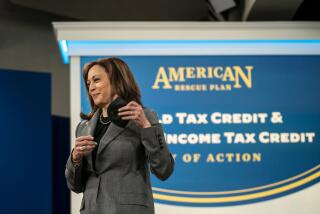Fact check: Romney’s tax claims challenged by nonpartisan report
Mitt Romney made two claims about his tax plan that deserve scrutiny: That it would not lower the tax burden on upper-income households and would not add $5 trillion to the debt over the decade.
Romney’s proposed tax changes would work like this: He would cut income tax rates by 20% across the tax brackets and eliminate taxes on capital gains and dividends for those earning less than $200,000; but to avoid lost revenue – keeping the plan “revenue neutral” – he calls for closing tax loopholes and deductions enjoyed by upper-income households.
“My number one principle is there’ll be no tax cut that adds to the deficit,” Romney said during Wednesday night’s debate. “I want to underline that – no tax cut that adds to the deficit. But I do want to reduce the burden being paid by middle-income Americans. And to do that that also means that I cannot reduce the burden paid by high-income Americans.”
The nonpartisan Tax Policy Center, a joint project of the Urban Institute and Brookings Institution, has said the Romney proposal would cost $360 billion in the first year before it is offset by closing loopholes, which others have extrapolated to estimate that it would amount to $5 trillion over the decade.
PHOTOS: Scenes from the first presidential debate
But Romney’s claim that his tax plan will not benefit upper-income earners runs into trouble in the Tax Policy Center assessment.
The report said the loopholes – popular deductions including those for mortgage interest, charitable giving and others – are not plentiful enough at the top of the income scale to cover the estimated $360-billion annual cost of reducing tax rates by 20%.
The gap would need to be filled by closing loopholes for those at lower ends of the income scale, those earning less than $200,000. Estimates say those earning between $100,000 and $200,000 would be significantly hit.
Also, the report said the trade-off between lower rates and loopholes would benefit higher-income households, which would see their overall tax burden go down while middle- and lower-income households would see their taxes rise.
“Cutting tax expenditures will result in a net tax cut for high-income tax payers and a net tax increase for lower- and or middle-income taxpayers,” the report said.
The Romney campaign has refused to say which loopholes it would close, and Romney did not clear up the question Wednesday. The campaign has said the choices would be debated in the future.
PHOTOS: Memorable presidential debate moments
The campaign has pushed back against the Tax Policy Center report, offering other economic surveys that show its tax plan can achieve its goals without hitting middle-income earners – largely by economic growth.
“Tax reform can also grow the economy by encouraging capital formation and promoting the proper allocation of capital across the economy. Romney’s plan will do just that,” wrote Alex Brill, a senior fellow at the American Enterprise Institute, in a defense cited by the Romney campaign.
The Tax Policy Center report did not account for economic growth, and such estimates among economists can vary.
Follow Politics Now on Twitter and Facebook
Twitter: @LisaMascaroinDC
More to Read
Sign up for Essential California
The most important California stories and recommendations in your inbox every morning.
You may occasionally receive promotional content from the Los Angeles Times.











